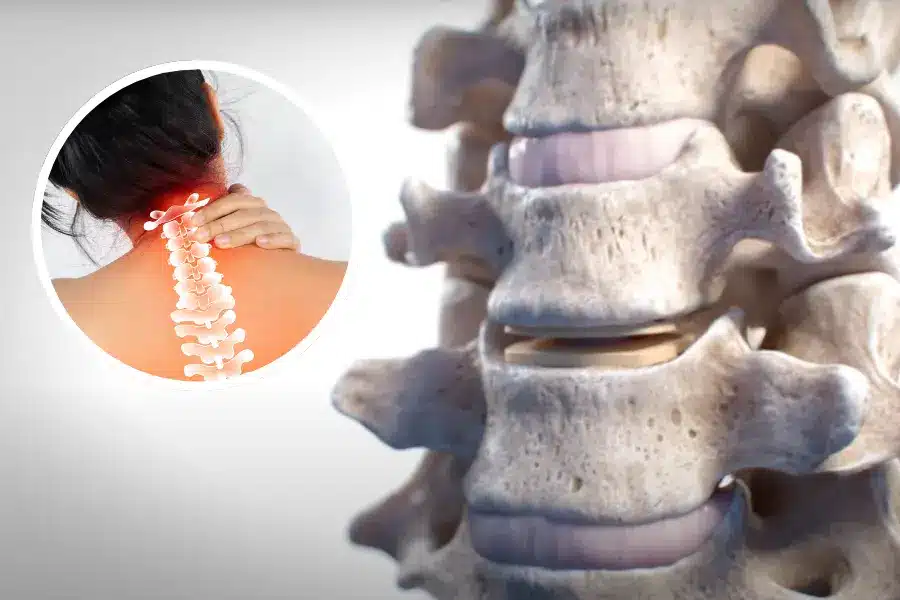
Which Cervical Artificial Disc Is Best for My Neck Condition?
Are you considering disc replacement surgery for your neck or cervical condition, but are unsure which artificial disc is right for you? In a world full of information and differing opinions, it can be overwhelming to sift through this data and determine what disc and doctor you should be trusting. We hear from our patients all the time about how the process of doing their research can be stressful and challenging. That’s why it’s crucial to find a spine surgeon that is equipped to guide you through this selection process and provide you with quality recommendations. Since 2005, our team at VSI has been at the forefront of minimally-invasive disc replacement surgery and has been a trusted destination for spinal care.
Which cervical spine conditions are a candidate for disc replacement surgery?
The most common spine condition that would require a cervical disc replacement is degenerative disc disease (DDD). This degenerative process takes place throughout the spine, but often occurs in the discs of the neck or cervical region. Pain generally occurs near the location of the affected disc and becomes worse with movement and activity.
Some other conditions that might require cervical disc replacement surgery are disc herniations, spinal stenosis, and failed prior surgery. A disc herniation is a displacement of disc material beyond the normal confines of the disc space, which often results in nerve pinching and shooting pain. Cervical spinal stenosis causes pressure on the spinal cord and exiting spinal nerves. Lastly, some patients are recommended for disc replacement surgery after a previous failed surgery that did not resolve their spinal issues.
The treatments for these spinal conditions depend on the patient and the affected area of the spine. If physical therapy and regenerative medicine treatment options are not providing results, artificial disc replacement surgery, also known as arthroplasty, may be the best treatment to restore quality of life for the patient. This decision is made in collaboration between the patient and the spine specialist, who looks holistically at the journey that the patient has made.
Which cervical artificial disc is right for me?
After twenty years of doing minimally invasive disc replacement surgery, our team of specialists have carefully selected an assortment of cervical disc implant options that best provide long-term success rates for our patients. These cervical disc types are Simplify, prodisc® SK, and prodisc® Vivo. They each have specific features that are considered when a specialist is deciding the best treatment options for a patient undergoing disc replacement surgery.
Simplify
The Simplify Disc is a well-supported and advanced cervical disc replacement that has been used in many surgeries and clinical studies. This disc is customized to a patient’s anatomy and prevents later problems while protecting the structure of the neck. This implant gained FDA approval for replacing one level of the disc in 2020 and two levels in 2021 in the C3-7 region of the neck. The Simplify Disc has many features that make it a great recommendation from surgeons for cervical disc replacement surgery:
- Disc heights: With a beginning disc height of 4mm, Simplify Cervical Disc offers low disc heights, better fitting patient anatomy and safeguarding facet joints.
- Radiologic design: Specialized endplates and a ceramic core enable postoperative comprehensive visibility on MR imaging.
- Preserving motion: The distinctive design of this disc permits coupled motion patterns, pure translation, and a changeable center of rotation.
prodisc® C SK & prodisc® C Vivo
The prodisc® C SK and prodisc® C Vivo are two differently structured discs that allow for a unique solution depending on the patient. The prodisc® C SK has a feature called the low profile keel which offers instant fixation to the spine structure. The prodisc® C Vivo is designed with an endplate with lateral spikes which also provides immediate fixation strength.
Both of these discs are designed to precisely fit the patient’s specific anatomical structure and are optimized for successful implantation during surgery. They both also have a texture and design which easily allows it to conform to the spinal structure. These discs also have eighteen options for sizes each to accurately conform to the specific level of the patient’s spine. Because of their adaptable capabilities and features, these discs can be tailored for each affected disc level, and have been effectively paired together in surgeries by our team at VSI.
How do doctors decide which disc to use?
When making the recommendation to move forward with surgery, a spine specialist should take into account various factors, including the patient’s anatomy, medical history, and recovery goals. In the case of two- or three-level disc replacement surgery, our surgeons may use a combination of different discs in order to tailor the surgery to each patient’s specific needs. Every patient is different and having an open line of communication will help the doctor have a full picture of what each patient needs. Customized care and building mutual trust is vitally important for the success of any surgery.
With all this information at the disposal of our spine specialists, they make careful decisions on what device and technology to use for each individual patient. Our surgeons are equipped to guide you through the selection process, and provide you with recommendations based on your specific anatomy and degree of your condition. As leaders in the advancement of the latest technology and techniques in artificial disc replacement surgery, our team ensures patients receive the best care to return to their full and active lives.
Topics covered
About the Author
Featured Resources
Insights to Achieve a Pain-Free Life



